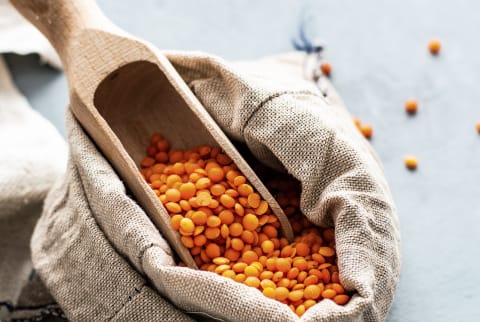A Guide To All The Types Of Lentils + 10 Recipes To Try


As the seasons change, my pantry shifts, too—and one ingredient I always rotate back in during chillier months is lentils. Sure, they occasionally make appearances in my summer salads and bowls, but one of my favorite cold-weather dishes is a good lentil soup.
"Lentils are a nutritious, delicious, and accessible food that make a great pantry staple," says Serena Poon, C.N., CHC, CHN, chef, nutritionist, and nutritional energy practitioner. "Lentils deliver important macronutrients and vitamins and can be stored in a well-sealed container in a cool, dry place for a long time." Not only that, but they're an easy, low-waste purchase since they're in the bulk sections of many stores.
Why you should be adding lentils to your pantry.
Beyond their solid shelf life, there are nutritional reasons to stock up on lentils, too. Similar to other legumes, they offer a good source of plant-based protein and fiber. They also offer "an array of vitamins and minerals, such as folate, potassium, iron, and manganese," according to Poon.
More uniquely, "Lentils are rich in polyphenols, which makes them potent antioxidants1," says Poon, "and also gives them properties that protect against inflammation and diseases." And that aforementioned fiber is a form of prebiotics, which fuel the good bacteria in our gut, to keep our gut microbiome thriving.
The notable nutrients among different lentil varieties are majorly similar, but according to Poon, "One standout is beluga lentils. These sturdy, black lentils also contain anthocyanins, which carry potent antioxidant properties."
The lentil varieties & how to cook with them.
When you do head to a store to pick them up, you'll find an array of varieties waiting for you—in a rainbow of colors, to boot. So how do you know what type to buy, and how should you cook with them?
If you're working with a recipe, it's best to follow their directions, because while the nutrient profiles may be similar, how they cook won't be. For more general prep, Poon had some advice for how to cook each type of lentil:
- Brown and green lentils: These are probably some of the most commonly used in the United States. "Brown and green lentils are a perfect choice for lentil soup or for a lentil purée," says Poon. "To make a simple, nutritious meal, blend an array of vegetables with cooked lentils, vegetable stock, and spices, and heat on the stove." To cook them, rinse them and then simmer for about 30 minutes, until they become tender.
- Red (or yellow) lentils: "Commonly used in Indian curries and dals, they also blend well into soups," says Poon. "Red lentils have a sweet and nutty flavor that pairs well with vibrant spices." They cook the quickest, taking only about 15 minutes to become tender, but they also break down some as they cook. This creates a creamy texture, perfect for stews.
- French lentils: Sometimes also called le puy lentils, these "tend to hold their shape more than other varietals and make perfect side dishes or salad additions," says Poon. In regards to flavor, there are some peppery undertones that pair well with aromatics like garlic and onions. "I love to create a simple side dish with prepared French lentils, garlic, and mirepoix," she says. These take about 25 minutes to reach ideal tenderness, and as with all varieties, should be rinsed before cooking.
- Beluga lentils: Along with their extra antioxidants, beluga lentils are extra resilient in texture. Poon explains that they "make a wonderful addition to a warm salad or stuffing" but also that she loves "mixing earthy beluga lentils with fresh, crispy veggies like cucumber, red onion, and a simple homemade lemon vinaigrette to enjoy as a stand-alone salad." These should be cooked to around al dente, about 20 minutes at a simmer.
10 lentil-based recipes to try.
When it comes to cooking with lentils, soup and salads are definitely a go-to, but there's so much more you can do with them. Here are some of our favorite recipe ideas:
- An M.D.'s stomach-soothing lentil soup
- A simple vegan chili with "exploded lentils"
- A hearty ragù with lentils and eggplant
- A one-pot vegan baked ziti with plenty of protein
- A salmon salad with French lentils and flavors
- A macro-bowl with plenty of probiotics
- A big bowl of vegan chili-mac for comfort
- A tahini and turmeric accented cauliflower-lentil salad
- A protein-packed kale caesar with lentil croutons
- A lentil soup that skips the lectins
If you want to up your legumes' nutrients, you can consider sprouting them (check out our guide here), which can make them easier to digest and improve the nutrient availability. So this winter, consider trying different cooking methods for these affordable little super-legumes—there are so many ways to prepare them, so you'll never get bored.

Eliza Sullivan is an SEO Editor at mindbodygreen, where she writes about food, recipes, and nutrition—among other things. She received a B.S. in journalism and B.A. in english literature with honors from Boston University, and she has previously written for Boston Magazine, TheTaste.ie, and SUITCASE magazine.